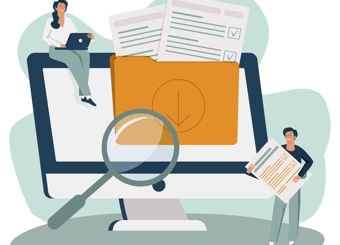How to use a pre-qualification questionnaire
If you’re a buyer, sourcing and onboarding the best suppliers is a crucial part of every project you oversee, whether you’re updating your company’s IT hardware or finding a new vendor in your supply chain. One of the best ways to find reliable vendors is to complete a request for information (RFI).
Put simply, an RFI is an evaluation system for potential vendors; it’s a list of questions that you send to suppliers which they are required to complete before they can work with you. These questionnaires are a great way of quickly sourcing a list of appropriate suppliers before you begin your detailed sourcing process.
The difference between a RFI and a sourcing event can seem a little vague, but they actually work in tandem to ensure that you hire the best vendor. In this article, we explain the strategy behind using RFIs, what you need to ask vendors, and what the next steps are once you’ve completed this process. This article is perfect for those with previous experience using RFIs who need a refresher, as well as junior members of the buying team looking to expand their procurement knowledge.
Note that an RFI is not the same as a request for proposal (RFP). Generally speaking, RFIs occur before RFPs; RFIs allow buyers to learn more about a vendor and gather general information, whereas RFPs require potential vendors to propose solutions to specific project needs. Buyers can then compare proposals from different vendors and determine which proposal best meets those needs.
Why use RFIs?
Conducting an RFI can often be overlooked and seen as a pointless box-checking exercise. However, it is a crucial stage in the supplier onboarding process, and offers an excellent system by which to measure how well a potential vendor meets your legal, financial, and operational needs.
Designing an efficient RFI process can be confusing, especially if you’re part of a large firm with numerous projects regularly onboarding new suppliers. Butthis is all the more reason to have an effective system in place, as it can:
- Reduce your supplier onboarding time
- Save your purchasing team time with a structured RFI process
- Reduce supply chain risk & leave the manual processes to the vendors
What needs to go in an RFI?
Regardless of the industry you’re in, there are eight areas that your RFI document should always include:
#1 – General contact details
This is the fundamental information you need to know about the vendor, such as:
- Key contact names, address, email addresses and contact numbers
- Website address and other online platforms
- Company registration numbers and legal status
- Company ownership information, partners, and names of directors
#2 – Financial information
Gathering information about a supplier’s financial situation is the best way of evaluating whether they have the appropriate resources and have the financial stability to meet your contract requirements.
The amount of detail that you request at this point can vary, but you want to be sure to get enough information to create a clear financial assessment. We advise asking for:
- Previous three-year turnover figures
- Credit rating and cash flow forecast & bank references
#3 – Insurance
This is potentially the most important information that you need to know as part of your vendor evaluation strategy; do they have the relevant insurance policies in place to cover any injuries, losses or damages?
If a vendor doesn’t have this insurance, you run the risk of being liable for damages and issues in their supply chain. The key types of insurance that you’ll want to look out for are:
- Employer’s liability insurance
- Public liability insurance & Product liability insurance
#4 – Quality assurance policies
You want to be sure that the goods or services that you receive always meet the agreed standard. Assessing whether your suppliers follow a quality assurance process is the best indicator that they will deliver to a consistent quality, so be sure to include a question about this in your RFI.
#5 – Health and safety standards
This point is similar to point #3e, but again, it is crucial that you check whether each supplier operates in conduct with current health and safety regulations. This will help avoid liability against accidents within the supply chain.
We recommend asking whether the vendor has a health and safety policy in place that confirms to government standards.
#6 – Environmental and Equal Opportunity goals
If your organization is passionate about developing a diverse workforce and is driving towards a more sustainable future, then your vendor sourcing strategy should focus on onboarding suppliers who share the same beliefs. Make sure you ask in your RFI about the efforts that they are making to achieve goals such as:
- CO2 reduction targets
- Plastic reduction measures & paper consumption reduction
- Ride to work programs & diversity and inclusion within the workforce
#7 – Professional and business position
Be sure to ask a potential vendor if their organization has any past convictions or certain offenses that have been committed by key shareholders of the business including as directors, partners or proprietors. If a supplier highlights a past conviction, you can choose whether or not to proceed.
#8 – Declaration
Now you need to add the declaration to your RFI. This doesn’t require the person completing the request to supply any more information, but it ensures that the information they provide is correct and accurate.
Distributing and evaluating returned RFIs
The next step is to send out your RFI. We recommend that you structure your questionnaire in a way that will easily identify key pieces of information that are important to you. By having a list of mandatory requirements or exclusions, you’ll save your purchasing team time in reviewing each response; they can simply fail vendors who don’t meet those requirements or exclusions.
Usually, these requirements and exclusions are related to previous legal issues, but Equal Opportunity and sustainability agreements are becoming increasingly important.
If you have used RFIs in the past, you most likely sent it out via phone or emails to suppliers that you’ve worked with before. Both methods require a member of your team to communicate directly with the supplier and they must assess their responses manually. Alternatively, you can use a sourcing platform, which will do all the hard work for you.
By using eSourcing, you simply have to add your RFI to the contract application process and it will be distributed around your client database. This means that all the vendors applying to work with you will complete the questionnaire themselves - and will either qualify or fail to proceed to the next stage automatically.
Next steps
By using an evaluation system including a RFI as part of your vendor sourcing strategy, you can streamline the process of obtaining a list of suppliers that fit your needs. Armed with this information, you can move on to the sourcing event or select a vendor to begin work immediately.






